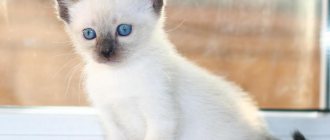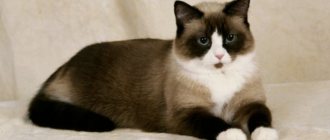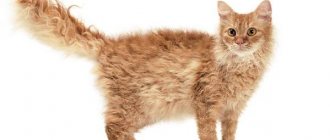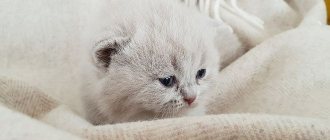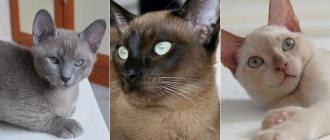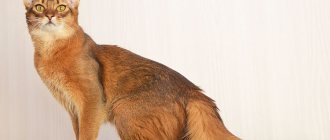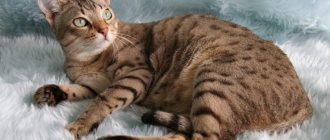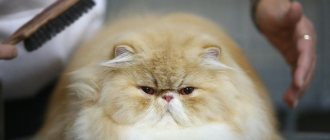History of the American Curl breed
All modern American Curls have a common ancestor - the cat Shulamith, picked up on the street in 1981 by a couple named Ruga. The spouses were pleasantly amused by the arched, as if turned inside out, ears of a mongrel kitty. But since the new owners were far from the subtleties of felinology, they were in no hurry to show the animal to specialists. In the same 1981, Shulamith acquired offspring. The father of a whole litter of purring fluffies was a mongrel and unknown cat. Nevertheless, almost all kittens born from him inherited their mother's curled ears.
American Curl
Joe and Grace Ruga were not ambitious, so at first they simply distributed the Shulamith babies to friends. However, in 1983, the couple turned their charges to a geneticist, who determined that the cat’s elegant “curly” ears were the result of a genetic mutation. Moreover, the gene responsible for this feature turned out to be dominant. This allowed Shulamith to enter into relationships with cats of any breed, producing babies with the same ear shape as her own. In the same year, Ruga's charges appeared at one of the cat shows held in California, which became good PR for them.
The American Curl breed received official recognition from TICA quite quickly - in 1987. At the same time, the “privilege” was granted only to semi-longhaired cats. Shorthaired Curls languished in anticipation until 1991, when the felinological organization finally decided to standardize them. It is worth noting, however, that the CFA recognized animals in both shorthair and longhair types, while the ACA and ACFA only did the same in 1993-1994.
Note: despite the fact that it is not customary to challenge Shulamith’s right to the status of the founder of the American Curl breed, it is worth clarifying that she was far from the only cat with such a mutation. Beginning in the 1960s, farmers in Oklahoma and California periodically encountered kitties with unusually fractured ear flaps, as evidenced by news reports from those years.
Vaccinations and antiparasitic treatment
Despite good heredity, the American Curl is defenseless against viral diseases. To preserve the life and health of the cat, it is regularly vaccinated with a complex drug that produces immunity:
- to panleukopenia;
- calcivirus;
- rhinotracheitis.
The first vaccination is given to a kitten at the age of 7-8 weeks. At 12-13 weeks, the American Curl is vaccinated against the same diseases and rabies. Subsequently, the cat is vaccinated once a year.
To prevent the Curl from suffering from parasites that carry various diseases, it is systematically treated for fleas and helminths:
- Anthelmintic drugs are given to the cat once every six months with mandatory repetition after 10-14 days.
- Curl fleas are removed using special shampoos or drops. And if the cat walks outside, he is additionally protected with an anti-parasitic collar.
American Curl breed standard
American Curl kittens
If in the story with the cat Matroskin, the identifying “documents” were whiskers, paws and a tail, then in the case of curls, ears alone are enough. The large, although not devoid of grace, “locators” of catfish from the New World form a noble curve, thanks to which it seems that the animal is constantly listening to something.
Head
American Curls have wedge-shaped heads with soft, smooth transitions. Representatives of this breed have a moderately long nose, a strong, well-defined chin.
Bite
Curls are characterized by a straight or scissor bite.
Eyes
Cats' large, slanted eyes have an elongated oval shape, commonly referred to as a "walnut." American Curl eye color is not tied to coat color and can be anything. An exception to the rule is individuals with color-point “coats”, whose iris should be bright blue.
Ears
The wide and large ears of American Curls are curved back and have a thin, rounded tip. According to the standard requirements, the angle of inversion of the ear cartilage must be at least 90°, but not more than 180°.
American Curl face
Frame
American Curls are distinguished by their plumpness and at the same time elegance of silhouette. The cat's body is flexible, rectangular, somewhat elongated, but quite muscular.
Limbs
The legs of American Curls are straight and of medium length. The paws are round, collected into plump “lumps”.
Tail
The tail of the American Curl is equal to the length of its body. In purebred cats, the tail is thick at the base, noticeably “thinner” as it approaches the thin, pointed tip.
Wool
Representatives of the long-haired variety of the breed have an airy, semi-adjacent coat, with a minimal amount of undercoat and guard hair. The neck and tail areas of cats are especially richly furred. The “outfit” of shorthaired Curls is less voluminous. They, like long-haired individuals, have virtually no undercoat, but the fur itself is more elastic and smooth.
Shorthaired American Curl
Longhaired American Curl
Color
In terms of colors, American Curls are allowed almost everything. Solid, Siamese, tabby, tortie, color point and bicolor - Curls made in the USA can have any of the colors, sometimes quite unexpected.
Disadvantages and disqualifying vices
At exhibitions, curls can qualify for a rating no higher than “good” if they have the following anatomical deviations:
- low-set, too steeply folded and directed anywhere but back ears;
- nose with a noticeable stop;
- too coarse or, conversely, cottony structure of the undercoat.
Individuals with too large a bend angle of the ear cartilage are not allowed to participate in exhibition events: when the tip of the ear touches the head. The same fate awaits Curls with too thick ear flaps, deformed cartilage (so-called “crimped ears”) and kinks in the tail.
Photo of American Curl
American Curl Personality
American Curls are the cutest creatures with an extraordinary appearance and angelic character, whom you just want to squeeze into your arms. Unlike most other representatives of the purring brethren, they are completely devoid of arrogance and militant independence and are truly attached to humans. To get along with an American Curl, you don’t have to take any special actions. This little eared dog loves its owner by default, but in turn expects the same manifestation of feelings from him. Most American Curls are sociable, curious cats who prefer to spend their leisure time in the company of a person. They will willingly surf the Internet with you, correcting the movements of the computer mouse with their furry paw, help you knit (or untie) another napkin, or simply lie on the sofa at your feet. However, one should not confuse the desire for close physical and emotional contact with obsession, which is absolutely not characteristic of curls.
How about a little attention?
The American Curl is one of the cat breeds that does not cope well with loneliness. Yes, a cat is capable of entertaining himself, but communication with a person cannot be replaced by either a mountain of goodies in a bowl or the most expensive gaming complexes. So before you buy a cat, think carefully about whether it will fit into your work schedule. The balance and natural calmness of American Curls allows them, if not to be friends with other domestic animals, then at least not to conflict. It’s hard to imagine what something so terrible would have to happen to make these good-natured purrs extend their claws and hiss threateningly at the dog or cat living in the same house with them. But kitties, as a rule, do not stand on ceremony with small animals. Hunting instinct - nothing can be done.
Another distinctive character trait of American Curls is the ability to painlessly adapt to the changing conditions of the surrounding reality. These cats adapt quickly and withstand moving and traveling relatively easily. Curls are also not irritated by noise effects, so if you throw a Friday party in your own apartment, the cat will not only not be scared, but will also try to take an active part in the festive event. The American Curl will also easily find an approach to guests who appear on the doorstep of the house, demonstrating its own disposition by quietly purring and cutting circles at the “newcomer’s” feet.
Description
As with any breed, the main thing for curls is harmonious proportions. Since the ancestors are ordinary cats, there is nothing unusual in the constitution of the animals. Normal weight should not be less than three and more than six kilograms.
American Curls have excellent health and are among the longest-livers in the cat world. Read about how long cats live.
Appearance
Apart from the specific shape of the ears, externally Curls are no different from ordinary domestic cats:
- they have a flexible and strong body;
- wedge-shaped head;
- scissor bite;
- proportionally folded paws;
- long pointed tail.
Various colors are allowed, the main thing is that if there are several colors, they are harmoniously combined with each other. Experts distinguish between smooth-haired and long-haired animals. But in both cases, the coat should be healthy and beautiful.
The length of the undercoat is so minimal that even in long-haired cats, the shedding process does not create problems for the owner.
Curls with an all-white coat may be deaf from birth.
Ears
Since the ears are a distinctive feature of the breed, characteristics have long been developed to determine their uniqueness.
Experts note that newborn kittens do not have a specific curve, and the auricle begins to change from the second day after birth and acquires its final rounded shape by four to five months of age. Curly ears should be turned back at an angle of 90 to 180 degrees and have a fairly rigid cartilaginous structure.
The laws of inheritance of curls have not yet been sufficiently studied. Therefore, when purchasing a Curl with strong ear curls, you need to be prepared for the fact that these qualities may not be transferred to the kittens and the ears may not be as curled as those of the parent.
Character
Some scientists are convinced that American Curls are one of the smartest cat breeds on the planet today. They are very friendly and inquisitive; unlike other cats, they are very active and do not lose these qualities even at an advanced age.
Thanks to their friendliness, they get along well with small children and other animals. Despite the predatory component, when properly raised, curls calmly react even to domestic parrots and fish in the aquarium, without attempting to hunt them.
At the same time, tolerant behavior can create difficulties for these noble animals if they are released to free range, since they will not be able to resist their more aggressive relatives.
It is best to take them out into the open air using a harness, which they quickly get used to.
Curl owners note that, unlike other cats, their pets do not need to repeat the “no” command twice. They are very neat and will never allow themselves to knock over a flower pot or tear apart the furniture.
They also show interest in house guests and express affection, allowing themselves to be petted and played. At the same time, “Americans” never impose their society.
Separation from the owner is difficult to bear, and they may even fall into depression, which will pass with the end of the separation. Read about stress in cats.
Another feature of this breed is that curls very rarely voice and there may be several reasons for this:
- they need the owner's help;
- it's feeding time;
- You need to change the filler in the tray.
Education and training
American Curls have a somewhat “dog-like” character. In other words, this is a breed that can be raised “to suit you” and even taught some tricks. The main thing is not to make excessive demands on the mustachioed good fellow, because he is just a cat and, in general, he has paws. However, learn individual dog commands, such as “Come to me!” or “You can’t!”, kitties are able to.
We're sitting well
When training an American Curl, it is necessary to take into account the mental characteristics of cats as a whole. For example, never repeat a command several times or modify it. An animal simply will not understand you if today you order it to “Sit!”, and tomorrow you simply invite it to “Sit!” Commands should be given in a soft but convincing tone. Remember, cats are not dogs and will not allow you to push them around. Give up the method of negative reinforcement in favor of positive one: give your American Curl treats even when he hasn’t coped with the job and be sure to praise him. And of course, don’t delay your upbringing: the older a Curl gets, the more difficult it is to convince him of the need for training. Yes, he may be the universal cutie and the most good-natured pet in the world, but this will not stop him from shirking his classes and turning on the “invisibility” mode.
Pros and cons of the breed
First of all, cats are loved for their gentle and easy-going nature. Curls are distinguished by excellent health and activity, as well as strong genetics. Thanks to good breeding work, many colors are acceptable. The main feature of American Curls is their curled ears.
This same feature is also the main disadvantage when choosing a representative of this breed - in the course of caring for a pet at an early age, its delicate cartilages, which are not protected by anything, can be damaged. Another obstacle for those wishing to become Curl owners is the low prevalence both in the breed’s homeland - in the USA and abroad, as well as its high cost.
Maintenance and care
The American Curl will need the same belongings as any other cat. In particular, for a purr you will have to purchase a bed or house, toys, bowls for food and drink, a carrier, a tray, and also a harness for walking. The house will also have to be put in order before the kitten moves. Remove any small objects from the floor that the baby might want to taste, and securely hide household chemicals, shoes and wires from household appliances.
Up to a year old, American Curl kittens suffer from excessive curiosity, which drives them to window sills, to open windows, into the drums of washing machines, ovens and trash cans, so at first it is better to carefully monitor the movements of the mustachioed lawless guy around the apartment. You can take an American Curl kitten outside no earlier than 2.5-3 months, and then only if the animal is vaccinated and dewormed. Adult cats are walked twice a day on a harness. The breed is considered active and playful; it needs constant fresh impressions, which can only be obtained outside the apartment; accordingly, it is wiser not to neglect the pet’s daily walks.
Oh yeah! Scratch me completely
Hygiene
The coat of the American Curl does not mat and hardly tangles, so a simple combing with a fine-toothed comb and a stimulating massage with a natural bristle brush is enough. Both short-haired and semi-long-haired individuals are combed using the same set of tools, but with different frequencies. In particular, it is recommended to comb the coats of short-haired Curls once every 7-10 days, and twice a week for long-haired Curls. American Curls shed seasonally and during such periods it is better to increase the amount of brushing: it is beneficial for the pet and there is less hair in the apartment. Sometimes a slicker is used to remove dead undercoat, which is insignificant in the breed.
Give me your paw!
It is better not to overuse bathing: two or three times a year is enough for the American Curl. They wash the purr with zoo shampoo, which is best selected with a cat cosmetics consultant. To give the coat a pleasant shine and make combing easier, it is advisable to use conditioner. Dry short-haired Curls with a cotton towel, and dry long-haired Curls with a hairdryer. In the intervals between baths, cats can be dry cleaned, for which it is worth purchasing powder and powder shampoos.
It is also necessary to clean the ears of American Curls, but due to the unusual structure of the ear funnels, this should be done with extreme caution. The ear cartilage of kitties is dense and easily breaks if you put too much pressure on it. Typically, the ears of American Curls do not produce much secretion, which looks like a dry dark coating, which is recommended to be removed once a month. It is better to examine your eyes daily. Representatives of this breed do not suffer from excessive lacrimation, but the tracks and lumps in the corners of the eyelids, of course, do not decorate the animal. So in the morning, wipe the corners of your Curl's eyes with a damp cloth.
It is better to brush your teeth once every couple of weeks. To do this, you will have to stock up on a cleaning composition from a veterinary pharmacy and a cat toothbrush. If for some reason such things are not available, you can limit yourself to a piece of gauze wrapped around your finger and baking soda. Even if a Curl has ten scratching posts hanging throughout the apartment, it is still necessary to trim his “scratches”, since in representatives of this breed they often grow into the pads. The only point: if you do not have experience in trimming claws as such, it is advisable to read the step-by-step instructions before the procedure, otherwise you risk touching a blood vessel in the claw and injuring your pet.
Feeding
Where's my food?
American Curls have an enthusiastic and reverent attitude towards food. Purrs with “twisted” ears love to fill their bellies, sometimes with things that are completely unsuitable for them. Don't be fooled by your pet's pleading looks and don't put a spoonful of roast or a piece of pie in his bowl. Firstly, because food from the table is unlikely to be appreciated by the cat's digestive system. And secondly, because such indulgences undermine your authority in the eyes of the animal.
American Curls should have their own “cuisine”, the basis of which is either high-quality super-premium “drying” or natural products. Moreover, in the second case, you will have to rely on lean meat (poultry, lamb, beef) and offal. Once a week you can treat your mustachioed gourmand to pork or beef cartilage (no fish or chicken bones). Suitable additions to the basic diet include oatmeal and rice porridge cooked in broth, low-fat kefir, fermented baked milk and cottage cheese. Vegetables are given to American Curls only in boiled or stewed form. These are mainly carrots, pumpkin, zucchini and beets. And of course, don’t forget about vitamin supplements with calcium, which help balance your pet’s natural diet.
How to feed an American Curl
Up to 6 months, kittens should eat 4-5 times a day. Six-month-old adolescents are fed 4 times and so on for up to a year. Starting from 12 months, the American Curl eats three times a day, since the transition to two meals a day occurs no earlier than by one and a half years.
Character and behavior
The American Curl is similar to Winnie the Pooh from a children's fairy tale: just as spontaneous and sometimes awkward, but sweet, playful and very kind. Cats of this breed completely lack the arrogance and desire to roam “on their own” that is inherent in many of their brothers: they adore people, crave company and are ready to spend the day and night next to their beloved owner.
Curls are alien to obsession: they will come running at your first call and come to wake you up with the first rays of the sun, but they will not restlessly crawl into your arm or meow mournfully in your ear, demanding entertainment. The sensitive Curl understands perfectly well when it is possible to climb onto your lap, and when it is better to hold off and stay away.
This breed absolutely does not tolerate loneliness, it grieves in separation so much that neither delicious food nor an abundance of toys can distract it from sad thoughts. Think ahead: can you give your clawed friend the right amount of attention? If your job requires frequent travel, daily deadlines, and long hours away from home, choose a cat of a different breed.
The American Curl is an attentive and fast hunter, a real threat to all small rodents and annoying insects. Therefore, such a cat and, for example, a tame rat, will not get along in the same territory. But the Curl will perfectly find a common language with other cats and even dogs and, if it does not make friends, it will not provoke any clashes or conflicts.
What does this pose mean in cats: crouching to the ground, arching their back, starting a mournful song?
Mating gamesPreparing for a fight
Adapts quickly to new surroundings and tolerates moving easily. He is not afraid of the bustle of the station, the noise of the plane and long journeys by car, the main thing is that his loved ones are nearby.
He does not shy away from guests, on the contrary, he tries in every possible way to greet them. He takes noisy companies with a bang and strives to get into the thick of the crowd. Easy to train: a curl can be trained to suit you and even learn some tricks and commands.
But remember that a cat remains a cat in any situation. Your tone should always be soft and affectionate. No swearing or swinging a slipper! Even such purrs as curls have a sense of self-esteem, which means that they can easily be offended by an orderly tone. Young animals grasp information on the fly, but it is much more difficult to persuade adults to do a somersault for a piece of liver.
Curls love walks and active games in the fresh air, so don't forget to buy a harness. The first walk can be taken no earlier than 3 months (the animal must be wormed and vaccinated in advance).
And remember: this breed has a real sense of adventure. Climbing into the drum of a washing machine (and getting stuck there), falling off a balcony, getting your head stuck in a jar, biting wires and getting an electric shock, knocking over a trash can, knocking all the flower pots off the windowsill - the list goes on and on. The owner will have to hide in advance everything that is prickly, cutting and anything that can fall and break.
You can buy a cat of the American Curl breed not only in the USA, where breeding is on a grand scale, but also in Russia, in St. Petersburg. Kittens are separated from their mother at the age of 4 months. A baby for home (without documents) costs 3-10 thousand rubles, for mating - 10-20 thousand, a cat for exhibitions - 25,000 rubles and more.
In the photo there is a cat of the American Curl breed: shorthair and longhair
How to choose a kitten
I'm already chosen
- Even in litters of famous curls with champion diplomas, babies with straight ears can “slip through the cracks.” And if a breeder shows you a flock of cats in which, along with “bow-eared” purrs, straight-eared cats run around, this is not yet a reason to suspect the cattery and its owners of all mortal sins.
- American Curl kittens rarely inherit the parental degree of ear curl. Accordingly, if when meeting a mother cat you find that her ears are not that curled, this does not mean that her offspring will have a similar feature.
- It is wiser to adopt American Curl kittens at the age of 2.5-3 months. The rather late date is explained by the fact that during the first weeks of life, the ear cartilage of babies is unstable and often changes the angle of inversion.
- Choosing a kitten with the steepest ear curl to ensure future access to exhibitions is an unnecessary safety net. This parameter has absolutely no effect on the show karma of the American Curl: individuals with a slight bend in the cartilage (but not less than 90°) often become champions.
- Check that the selected kitten has the necessary documents (metrics, veterinary passport), as well as the presence of an electronic chip on its body.
Feeding the cat
For proper development and good health, the Curl needs a balanced diet. It doesn’t matter whether it’s dry or natural food.
Complete diet
When feeding natural food, sources of animal protein should predominate in the Curl's menu. It could be turkey, chicken, beef, rabbit or veal.
Also in the cat's diet should be present:
- cereals;
- eggs;
- sea fish;
- vegetables;
- offal;
- sour milk.
It is strictly forbidden to feed the American Curl pork, river fish, sweets, pastries, sausage and any leftovers from the owner’s plate.
If it is planned that the cat will eat dried food, then the choice is made only on high-quality premium or super-premium food. Best suited for American Curls:
- Pro Plan;
- Acana;
- Royal Canin;
- Arden Grange.
Important! A cat who eats dry food should have easy access to a bowl of clean drinking water.
Feeding frequency
The kitten eats in small portions, but often. Therefore, the feeding regimen of the American Curl depends on its age:
- up to 6 months – 5 times a day;
- 6-12 months – 4 times a day;
- 12-18 months – 3 times a day.
A one-and-a-half-year-old American Curl is switched to a double feeding regimen.
Vitamins and minerals
When feeding natural food, the American Curl's body may experience a lack of any microelements. To compensate for this deficiency, the cat is given vitamin and mineral complexes twice a year.
Curls best absorb valuable substances from Polidex Immunity and Canina Canivita. But before giving them to your cat, it is recommended to discuss this issue with your veterinarian.
